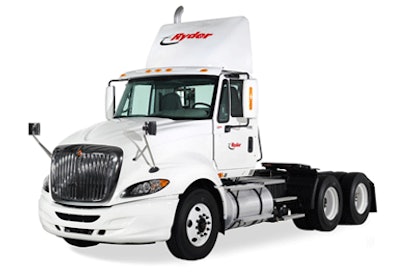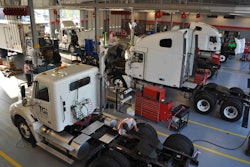
With summer bearing down, fleet tire maintenance becomes even more important.
More heat means more tire failures which means costly downtime and more road gators—large chunks of tire debris which have been known to cause vehicle damage and accidents and generate unflattering headlines.
Fleets are also feeling the ‘heat’ of increased fuel efficiency regulations coming soon under Phase II of the greenhouse gases (GHG) emissions and fuel efficiency standards proposed jointly by the U.S. Environmental Protection Agency and the National Highway Traffic Safety Administration (NHTSA).
Regarding GHG Phase II, the EPA states: “Like Phase 1, the proposed Phase 2 standards would apply to a wide range of on-road vehicles, from the largest pickup trucks and vans to semi-trucks – and for the first time, would also include trailers.”
 Ryder says you can’t beat the basics when it comes to tire care, which includes regular air pressure and tread checks.
Ryder says you can’t beat the basics when it comes to tire care, which includes regular air pressure and tread checks.Implementation for EPA GHG Phase II begins with model year 2018 for trailers and then model year 2021 for medium and heavy duty vehicles. NHTSA trailer standards are set to begin in 2021.
Phase II GHG rules will require non-box trailers, such as tank, flatbed and container chassis to use automatic tire inflation systems and lower rolling resistance tires.
Hard Working Trucks interviewed Scott Perry, Ryder’s vice-president of supply management and global product management to learn more about how one of the nation’s top fleet management companies is tackling tire care. Below is part 1 in a three-part series, Ryder talks tires as new regs approach.
HWT: Thank you for taking the time for an interview.
Perry: Happy to do so. The (Ryder) Total Tire Management program is something that has been evolving for a couple of decades, so it’s a pretty mature program within our world. For us, tires are—from a maintenance perspective—the single largest line item expense for maintenance within our fleet. It definitely garners a lot of attention from us with regard to how we select our primary tire vendors, but more importantly, how we treat those tires throughout their lifespan, how we cascade tires as far as through the retreading process, and how we monitor their age and make sure that they don’t stay in our system too long.
Perry (cont’): We do have a casing age and grading program to make sure that we are not repurposing tires too many times through our network. We have specific protocol around the number of repairs that we’ll allow to a tire before it has to be cycled out of our fleet, just because we know that when those repairs occur, even though they may be a very high quality, it does degrade the overall life expectancy of the tire or increases the probability of failure. And we’re very, very focused on uptime for our customers and not creating a potential scenario whereby the tire may fail and result in a road call for the customers. So there’s really everything, from when the vehicle is first purchased and delivered—which we control generally—the tire that is spec’d for that application and that vehicle configuration and the way that we treat the tire through its life.
Perry (con’t): Generally a tire or a truck doesn’t roll through our maintenance network without having pressure and tread depth and making sure that we’re just doing the basics. And that’s probably the biggest, single thing around tire performance. It’s not necessarily the brand on the side—and we’ve got some really strong brand partners in Bridgestone and Bandag and have been aligned with them for many, many years—the tire compound and the way the tire treads are produced, those are important, but when it comes to total life expectancy, keeping the proper amount of air pressure in those tires and keeping axles aligned are probably the two key variables in making sure that tire has a full productive life outside of some unnatural event, such as running over something in the roadway or some type of physical damage occurring to it.
Perry (con’t): Tire inflation is very, very critical. You hit on something that’s very important that we watch very closely and that is that if we do have a tire failure, or road call, we’re very conscious of the fact of how it’s counter-productive to put a brand new tire onto an axle that has a tire that’s worn half-way through its life. We have parameters around making sure that we’re matching up tread depths, even after a repair may occur on the side of the road. Whenever that truck comes back through to our shop we’ll check and if it’s more than 2/32-inch difference between the two tires on the same axle—the same side of the same axle—we’ll remove the tires and then match up a set of either mid-life tires or new tires side by side and put them back on the vehicle because we know that if we leave it on for too long it’s just going to scuff away all of the good tread that’s on the new tire and also creates uneven wear on the partner or the paired tire that’s matched on that side.
Perry (con’t): So, there’s a lot of focus and emphasis that’s done on that. You can imagine that with the number of vehicles that we have it is not a perfect system, but it’s a system that we train to and have a high degree of compliance around to make sure that everyone understands why we’re doing what we’re doing and fall into that vein of trying to make that tire last as long as possible and create an environment where our customers aren’t experiencing tire failure events and taking the vehicle out of service on the side of the road.
Look for Ryder talks tires as new regs approach, part II tomorrow.









